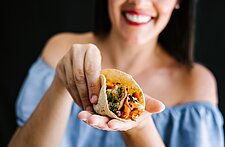Where’s the beef? Clara Peller from Wendy’s ads of the ‘80s might have had a different answer, but these days, a lot of that beef can be found in Latino households across the U.S. According to a recent Iconoculture study, the average Latino consumer purchases roughly $326 worth of beef every year, compared to other shoppers, each of whom spends about $230 on beef each year.
But it’s not just beef. There’s also chicken and pork, plus unexpected carne, such as goat. Clearly, Latinos enjoy meat with their meals. In fact, Latinos include meat in their meals four to five days each week, while others serve it just two to three days per week.
How is that meat being consumed? Traditional favorites, such as tacos and burritos, are staples in many Latino households. But you’ll also find some of that meat in trendy sancocho stew, plus cemitas, carnitas, pique macho, and barbacoa, a distinctly Mexican take on barbecue. And then there’s cechina seco, a dried beef that’s a great complement to scrambled eggs, as well as lengua, or beef tongue, which can be found in a variety of dishes, as well as on its own. And that’s just a sampling; Latinos have a wide, varied, and delicious roster of choices, many of them centered on meat.
It’s a big – and quickly growing – market. But serving it right may mean changing the way you market and sell your meat products. To help you better connect with Latino meat buyers, here are a few tips:
Friendly, Personal Service Matters
Whether they’re purchasing pre-cut selections from the case or opting for cut-to-order meat, Latinos commonly look for a meat cutter or counter person who will take the time to answer questions and engage in a little friendly conversation. For these shoppers, the social component of shopping is an important part of the overall experience, and the little touches, such as remembering customer names and chitchatting, can make a big difference in shopper satisfaction and retention.
Freshness, Variety, and Value Keep Latinos Coming Back
Regarding the meat itself, freshness is key for Latinos, as is competitive pricing. Having the right cuts of beef on hand is also important. Often, Latinos prefer thinner cuts, such as ranchera (thinly cut flank or skirt steak) and thin-sliced, pounded flat steak for making breaded milanesas, in addition to standbys like top loin and blade, brisket, and eye of round. For a more complete selection, meat retailers who serve Latinos should consider stocking shank cross cut beef, espinazo (neck bone), and tripa (intestines), in addition to favorites like chorizo (spicy sausage), morcilla (blood sausage), and patas de puerco (pig's feet).
More Tips for Better Serving Latino Meat Consumers
Apart from offering the right cuts of fresh meat and making time to develop a friendly relationship with customers, meat retailers should consider bilingual packaging and signage. While many, if not most, U.S. Latinos are comfortable speaking and reading English, packaging and signage that’s available in Spanish shows your commitment to offering the best possible service to your Latino customers, as does the availability of a bilingual meat cutter or counter representative. If you do have a bilingual meat cutter on staff and ready to help, advertise it with a sign that says Carnicero que habla español en servicio (Spanish-speaking butcher available). And of course, give all your Latino customers a warm gracias for shopping with you.





